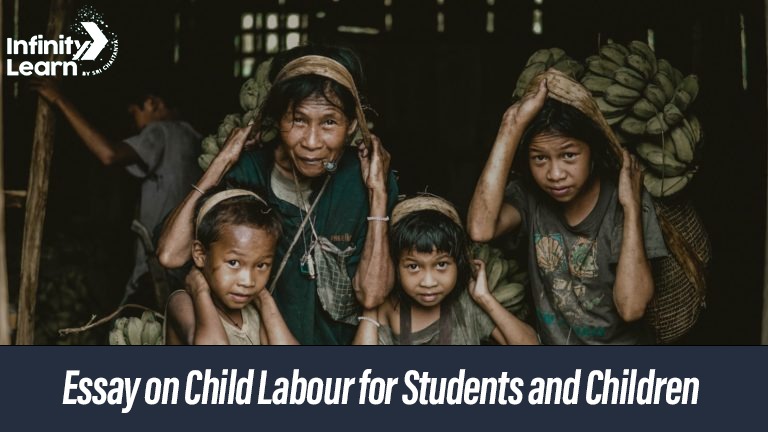Table of Contents
Child Labour Essay: Child Labour refers to the employment of children aged 5 to 17 years to deprive them of their childhood and force them into a life of deprivation and illiteracy. The main factor behind child labour is poverty; therefore, it is more rampant in developing or underdeveloped countries. Children in these countries are often forced into labour to supplement the daily income of their families.

Short and Long Essay on Child Labour
For your information and knowledge, we have provided a short and long essay on Child Labour in English. These Child Labour essays have been written in simple yet effective English for you to make it easy to remember them and present them when required.
After going through the essays, you will learn a lot about child labour and its vital statistics. You will also know about the industries employing child labour in India; the negative effects of child labour on children; ways to tackle child labour; how child labour is related to poverty; the history of child labour; types of child labour in India, and statistics of child labour in India 2019.
These Child Labour essays will be extremely useful in your school/college assignments and competitions like speech giving, debate, and essay writing competitions.
Child Labour Essay 1 (100 Words)
- Child labour is the employment of children, often aged 5 to 17 years. At such a young age, children are a lot less demanding and could be very easily managed by the employees. For this reason, many unorganized sectors worldwide prefer to work with child laborers.
- There are nearly 152 million child labors worldwide, most driven by poverty. Low-income families unable to meet daily nourishment requirements are forced to send their children to manual work in different sectors. This way, the children could supplement their family’s income apart from fending for their vital requirements.
Child Labour Essay 2 (150 Words)
- Child labour is defined as the employment of children in such a way as to deprive them of their childhood, education, and growth opportunities. Many unorganized small sectors worldwide prefer to employ children for they are less demanding and easily manageable.
- Sometimes, the families of the children themselves push them into child labour for want of money, or they cannot feed the children. Such children often live in unhygienic and deprived conditions, with no medical aid and no education opportunity.
- Child labour forces a child into the vicious cycle of deprivation, illiteracy, and poverty. Such children cannot find a decent and suitable job as adults and are often regarded as socially backward. They live solitary lives of isolation and often take to unwanted and unethical means.
Are you looking for JEE Study Material 2025? Infinity Learn offers comprehensive study material for your JEE preparation.
Child Labour Essay 3 (200 Words)
- Child Labour refers to the employment of children in various sectors worldwide. It includes mining, production industries, farming, and other unorganized sectors. Children is often employed in these sectors for they are paid less and easy to manage.
- Child labour is widely practiced worldwide and deprives children of their childhood, education, and other growth opportunities. Children is forced to engage in hazardous working conditions to support their families by supplementing their income.
- They work under a verbal or written contract between their employer and parents. Sometimes, it is to repay a debt taken by their families from the employer. Child labour is more common in developing and underdeveloped nations. Love ty is the main driving factor behind child labour as the children are forced into child labour by their own families to fend for their everyday requirements for food and other necessities.
- There are many strict laws against child labour, and many countries, including India, have norms of imprisonment and fine if a person and organization is found involved in child labour. We still need to forcibly implement them if we want child labour to be eliminated.
Child Labour Essay 4 (250 Words)
- The term “Child Labour” refers to the employment of young children in various sectors like industries, hotels, farming, etc. The time is used mainly to denote the employment of children falling in the age group of 5 – 15 years.
- Child labour deprives the children of their childhood and proper physical and mental growth opportunities. It a so considerably reduces a child’s possibility of getting educated and progressing in life.
- Worldwide, around 218 million children aged 5 to 17 years are employed as child labour. The children are subjected to live in poor hygienic conditions and are deprived of the basic necessities of life.
- They never get an opportunity to go to school, forcing them into decades of poverty and labour. Working in poor health conditions, they also become susceptible to various diseases, and their conditions are rarely addressed.
- Such children are also subjected to living in isolation and are not allowed to interact with people socially and make friends or play. Such a poor work environment is stressful for a child and often results in several mental conditions like depression. Such children often take drugs and other substances, resulting in further physical and mental damage.
- There is a need to strictly supervise the sectors prone to employing children and impose harsh penalties with money and imprisonment on them for doing so.
Child Labour Essay 5 (300 Words)
Introduction
Child labor is the employment of children for different works to interfere with their normal mental, physical, and social growth opportunities. T al o deprives the children of the much-needed education.
Industries Employing Child Labour in India
There are five major sectors in India employing children as child labors as described below-
- Garment Industry – Child labour constitutes a considerable workforce in the Indian garment industry. E industries operate in small owner-managed setups mainly operated from homes. Ads of children in Delhi are employed by the garment industry and are subjected to loud noise, extensive working hours, and sharp tools.
- Unorganized Sectors – This sector is one of India’s greatest employers for children. It every easy to spot a child working in dhabas, roadside eateries, tea shops, and other businesses. Children are also employed in small shops as servants or help. Based businesses prefer to employ children as they are easily manageable and cost less.
- Brick Kilns – The brick kiln industry of India has long been witnessing child labour. Children in brick kilns work for long hours with their parents. Working in the brick kiln are exposed to hazardous conditions and toxic fumes, and heated temperatures.
- Fireworks – The fire sector is India’s most significant employer for children. N this sector often work in cramped spaces and are exposed to dangerous chemicals and hazardous substances, posing a risk to their health and life, and so forced to work for long hours during the festive season.
- Agriculture – The agriculture sector might be the biggest employer of children in India. E hired in cotton, sugarcane, paddy, and other agriculture-related fields. C il e working in agriculture have to work for longer hours, are paid less, and work in unhygienic conditions.
Conclusion
Children are forced into child labour due to poverty and to supplement their family’s income. Its necessary to identify these sectors and make necessary policies and laws to prevent the employment and exploitation of children in these sectors.

Child Labour Essay 6 (350 Words)
Introduction
The engagement of children as manual labors in different organized and unorganized sectors is termed child labour. Deprive children of their educational opportunities, growth opportunities, socialization, and health is physically and mentally harmful to the students.
Adverse Effects of Child Labour
- Child labour has many negative impacts on children. Children involved in child labour often work in dangerous and life-threatening conditions, without proper care or support. They are paid less than adults doing the same work and are frequently underfed, further compromising their health and well-being.
- Their employers do everything to keep them cut off from the other parts of the world, forcing them to live a life of isolation and labour; re not n allowed to talk to or meet anyone. An io like this often results in mental disorders like depression, drug addiction, substance abuse, etc.
How can we Help to Stop Child Labour?
We can take a few simple steps to help stop child labour.
Also, keeping an eye on the businesses employing children and reporting the same to competent authorities will prove helpful in eliminating child labor.
At workplace risk assessment for the dangers it poses to the children must also be carried out. Hiring chi e for work should be immediately stopped at any cost.
Child Labour and Poverty
One of the main factors contributing to child labor is poverty. Many children are forced to work in order to help support their families financially. They often provide actual labor either by being employed directly by an employer in exchange for money, or by being engaged in their family’s traditional businesses. This exploitation arises due to the lack of economic resources, compelling families to rely on their children’s work for survival.
For instance, poor farmers in India are forced to use their children as labor because it would be difficult to pay for adult laborers.
Conclusion
Child labor is a serious issue that hampers both national and global progress. It deprives children of their rightful childhood, love, and education, forcing them into grueling, dangerous, and isolating conditions. This exploitation not only impacts their physical and mental well-being but also limits their potential for a better future.
Child Labour Essay 7 (400 Words)
Introduction
Child Labour refers to the employment of children in various sectors to deprive them of their childhood, education, and other growth opportunities and cause physical and mental harassment. Prime reason behind child labour is poverty, and more often than not, the children are employed to supplement their family’s income.
History of Child Labour
- During the preindustrial societies, the concept of childhood was in existence. Even as young as one year old, children were involved in activities like hunting, woodcutting, and farming. While this may not be considered child labor in the traditional sense, these tasks were performed to support the survival of their family or community. These early responsibilities helped sustain their group, but they still placed a burden on the child’s development and well-being.
- Low productivity and low life expectancy were two of the main characteristics of the preindustrial area. Preventing children from engaging in productive work would hinder their progress and reduce their chances of survival. In those times, physical labor was often seen as more essential for survival than the development of skills.
- The exploitation of children as child labour began in the late 18th century with the industrial revolution.
In Britain, cities like Birmingham and Liverpool rapidly transformed into major industrial hubs, drawing millions of people from villages and rural areas. A similar situation occurred in other developing economies as well. - The Victorian era in Britain ranged from 20 June 1837 to 22 January 1901. It was notorious for child labor, with children as young as six employed in factories and mines during the Victorian era, where they worked in unimaginably harsh and life-threatening conditions.
World Statistics on Child Labour
Global statistics show that nearly 218 million children are employed worldwide, with 152 million of them engaged in child labor between the ages of 5 and 17. Among them, around 73 million work in hazardous, life-threatening conditions.
In terms of regional distribution, Africa accounts for approximately 72.1 million child laborers, nearly half of the global total. The Pacific region follows with 62 million, while the Americas have 10.7 million. Central Asia, Europe, and the Arab states contribute 5.5 million and 1.2 million, respectively.
Conclusion
Child Labour has existed for centuries, even in some of the world’s developed economies. At times, the reason for child employment is to make them employable, while in other cases, it serves to supplement the family’s income. However, in both situations, it disrupts the child’s development, education, and overall well-being.
Also Read Related Topics
- Slogans on Child Labour
- Paragraph on Child Labour
- Speech on Child Labour
- Child Labour in India
- Child Rights Day
- National Girl Child Day
- Children’s Day
- Essay on Bal Swachhta Abhiyan
- Essay on Poverty
- Essay on Corruption
- Essay on Beti Bachao Beti Padhao
- Essay on Beggars
Child Labour Speech 8 (500 Words)
Introduction
Child labour refers to the exploitation of children by involving them in work that robs them of their childhood, education, and development, causing both physical and mental harm. While child labour laws are enforced globally, including in India, there is an urgent need for more effective implementation to protect children from such exploitation.
Causes of Child Labour in India
The UNICEF (United Nations International Children’s Emergency Fund), a United Nations agency responsible for providing humanitarian and developmental aid to children around the world, states poverty is the biggest cause of child labour in India and other developing and underdeveloped countries around the globe.
Due to poverty, children are subjected to labour to supplement their family’s income. the absence of good infrastructure in rural India and a lack of awareness are reasons behind child labour in India.
Types of Child Labour in India
In India, two main types of child labour exist: debt bondage child labour and the employment of children to supplement their family’s income. In both cases, the child’s autonomy is often compromised, with the will of others being partially or fully imposed upon them.
Debt bondage child labour involves a child being employed to work in order to repay a debt incurred by their parents. This arrangement may be formalized through a verbal or written agreement. Despite laws prohibiting such practices, bonded child labour remains prevalent in certain areas of India.
The second form of child labour occurs when parents agree with an employer to have their child work to help support the family’s income. Poverty is the root cause behind both types of child labour in India and globally, contributing to the persistence of these harmful practices.
Download NCERT Solutions for CBSE Class 6-12 for free on Infinity Learn.
Child Labour in India Statistics 2019
Statistics provided by UNICEF revealed that nearly 10.1 million children in India engaged in child labour. Children fall in the age 14 years 4.5 million girls and 5.6 million boys. 0% of child labors employed in rural India.
Child Labour in India is more prevalent in Uttar Pradesh (2.1 million), Bihar (1 million), Madhya Pradesh (0.7 million), Maharashtra (0.72 million), and Rajasthan (0.84 million).
Indian industries employing a major share of child labors in India are the cotton industry, matchbox making industry, agriculture sector, and other small unorganized sectors.
Child Labour Laws in India
Several laws have been enacted in India to prohibit the engagement of children in labor. Key legislations include the Juvenile Justice (Care and Protection of Children) Act, 2000, and the Child Labour (Prohibition and Abolition) Act, 1986. These acts serve as the foundation for all child labor laws in India, aiming to protect children from exploitation and ensure their rights to education and a safe childhood.
Conclusion
Child labour is a serious obstacle to a nation’s growth, as well as its social and economic development. While many laws exist to eliminate child labour, their effective implementation is crucial for bringing about meaningful change.










